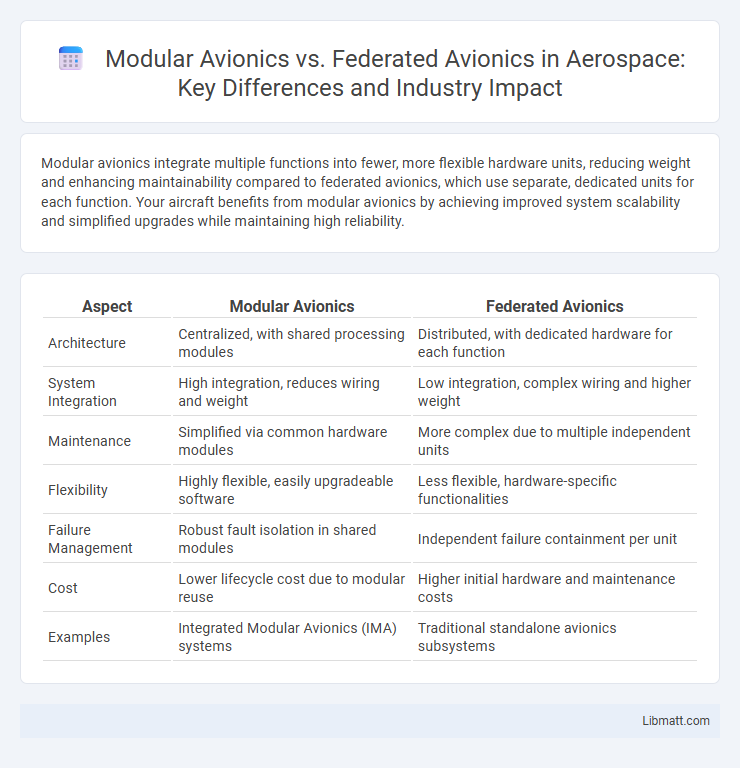Modular avionics integrate multiple functions into fewer, more flexible hardware units, reducing weight and enhancing maintainability compared to federated avionics, which use separate, dedicated units for each function. Your aircraft benefits from modular avionics by achieving improved system scalability and simplified upgrades while maintaining high reliability.
Table of Comparison
| Aspect | Modular Avionics | Federated Avionics |
|---|---|---|
| Architecture | Centralized, with shared processing modules | Distributed, with dedicated hardware for each function |
| System Integration | High integration, reduces wiring and weight | Low integration, complex wiring and higher weight |
| Maintenance | Simplified via common hardware modules | More complex due to multiple independent units |
| Flexibility | Highly flexible, easily upgradeable software | Less flexible, hardware-specific functionalities |
| Failure Management | Robust fault isolation in shared modules | Independent failure containment per unit |
| Cost | Lower lifecycle cost due to modular reuse | Higher initial hardware and maintenance costs |
| Examples | Integrated Modular Avionics (IMA) systems | Traditional standalone avionics subsystems |
Introduction to Avionics Architectures
Modular avionics architecture centralizes computing resources into shared hardware modules, improving scalability and maintenance compared to federated avionics, where each function operates on dedicated, separate hardware. Your choice between modular and federated architectures impacts system integration complexity, weight, and reliability in aircraft design. Emphasizing modular avionics can lead to enhanced flexibility and lower lifecycle costs while federated systems offer simplicity and established certification pathways.
Defining Modular Avionics
Modular avionics refers to an aircraft's electronic system design where individual modules or components are standardized and independent, allowing for easy upgrades, maintenance, and scalability. Unlike federated avionics, which uses dedicated hardware for each function, modular avionics integrates multiple functions into shared computing resources to optimize weight, power, and cost efficiency. This approach enhances system flexibility, enabling quicker integration of new technologies and improved fault tolerance in modern aerospace applications.
Understanding Federated Avionics
Federated avionics architecture consists of distinct, function-specific hardware modules, each dedicated to a particular avionics task such as navigation, communication, or flight control. This segregation offers simplicity in design but often results in increased weight, higher power consumption, and reduced scalability compared to modular avionics. Understanding federated avionics highlights challenges in system integration and maintenance that modular avionics aim to address through a more flexible, centralized computing platform.
Key Differences Between Modular and Federated Avionics
Modular avionics integrate multiple functions into shared hardware platforms, enhancing scalability and reducing weight and maintenance complexity, while federated avionics utilize separate, dedicated units for each function, offering easier certification and fault isolation. Modular systems rely on standardized interfaces and software abstraction layers to enable flexible upgrades and interoperability, contrasting with the fixed wiring and hardware-specific designs typical of federated architectures. The shift to modular avionics supports advanced data processing and system integration demands in modern aircraft, whereas federated systems remain prevalent in legacy platforms for their straightforward architecture.
Advantages of Modular Avionics Systems
Modular avionics systems offer enhanced scalability and flexibility by enabling easy upgrades and replacements of individual components without redesigning the entire system. They improve fault tolerance and maintainability through standardized interfaces, reducing downtime and maintenance costs. This approach also supports faster integration and testing processes, accelerating development cycles compared to traditional federated avionics architectures.
Benefits and Limitations of Federated Avionics
Federated avionics systems centralize components and functions within dedicated hardware units, offering straightforward integration and well-established reliability in aerospace applications. Their benefits include simplified certification processes and ease of diagnosing faults due to isolated modules, but limitations arise from higher weight, limited scalability, and increased wiring complexity. You may face challenges in upgrading or expanding federated systems compared to modular avionics, which provide better flexibility and resource optimization.
Integration and Scalability in Avionics Design
Modular avionics offers superior integration by utilizing standardized hardware and software components that simplify system upgrades and maintenance, promoting scalability across different aircraft platforms. Federated avionics systems rely on dedicated hardware for each function, which can complicate integration and limit scalability due to increased weight and space requirements. Emphasizing modular design enhances both integration efficiency and scalability, enabling flexible avionics configurations tailored to evolving technological advancements and mission needs.
Maintenance and Upgradability Comparison
Modular avionics offer enhanced maintenance and upgradability compared to federated avionics due to their standardized hardware and software interfaces, enabling easier replacement and integration of components. Federated systems require more extensive downtime and specialized knowledge for maintenance since subsystems operate independently with proprietary designs. The modular approach reduces lifecycle costs by facilitating rapid upgrades and minimizing aircraft grounding times during system enhancements or fault repairs.
Safety, Reliability, and Redundancy Considerations
Modular avionics systems enhance safety and reliability by isolating faults within independent modules, enabling easier maintenance and upgrades without impacting the entire system, while federated avionics rely on dedicated hardware for each function, which can increase redundancy but may complicate system integration. Redundancy in modular avionics is achieved through distributed computing and software-based fault tolerance, offering scalable and flexible backup options, whereas federated systems use physically separate units to provide redundancy, potentially leading to higher weight and complexity. Safety certifications often favor modular avionics for their fault containment and ease of verification, while federated architectures are traditionally trusted for proven hardware segregation.
Future Trends in Avionics Architecture
Modular avionics architecture is rapidly advancing with an emphasis on scalability, reconfigurability, and enhanced software integration, enabling more efficient hardware utilization and faster upgrades. Federated avionics, while still prevalent, faces challenges due to its rigid hardware dependencies and increased weight, limiting flexibility in future aircraft designs. Your aerospace projects benefit from adopting modular systems that support emerging technologies such as artificial intelligence and cybersecurity, ensuring adaptability in dynamic flight environments.
Modular avionics vs Federated avionics Infographic

 libmatt.com
libmatt.com